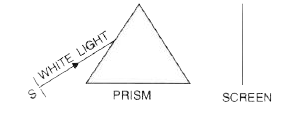(a) A beam of monochromatic light undergoes minimum deviation through an equiangular prism. How does the beam pass through the prism with respect to its base?
(b) If white light is used in the same way as in part (a) above, what change do you expect in the emergent beam?
(c) What conclusion do you draw about the nature of white light in part (b)?
(a) parallel to the base, (b) white light splits into its constituent colours i.e., spectrum is formed (c) white light is polychromatic
Topper's Solved these Questions
- BOOK - ICSECHAPTER - SPECTRUMEXERCISE - EXERCISE A (MULTIPLE CHOICE TYPE)6videos
SPECTRUM
- BOOK - ICSECHAPTER - SPECTRUMEXERCISE - EXERCISE A (NUMERICALS)4videos
SPECTRUM
- BOOK - ICSECHAPTER - SPECTRUMEXERCISE - TYPE 3 DIAGRAM BASED MCQ:5videos
SPECTRUM
- BOOK - ICSECHAPTER - SPECIMEN QUESTION PAPEREXERCISE - QUESTIONS33videos
SPECIMEN QUESTION PAPER
- BOOK - ICSECHAPTER - WORK,POWER AND ENERGY EXERCISE - DIAGRAM BASED MCQ3videos
WORK,POWER AND ENERGY
Similar Questions
Fig. shows a thin beam of white light from a source S striking on one face of a prism.

(a) Complete the diagram to show the effect of the prism on the beam and to show what is seen on the screen.
(b) If a slit is placed in between the prism and the screen to pass only the light of green colour, what will you then observe on the screen?
(c) What conclusion do you draw from the observation in part (b) above?View SolutionThe diagram shown below in Fig. 6.8 shows the path taken by a narrow beam of yellow monochromatic light passing through an equiangular glass prism. If the yellow light is replaced by a narrow beam of white light incident at the same angle, draw another diagram to show the passage of white light through the prism and label it to show the effect of the prism on the white light.
 View Solution
View SolutionA ray of light incident at an angle of incidence 'I' passes through an equilateral glass prism such that the refracted ray inside the prism is parallel to its base and emerges from the prism at an angle of emergence 'e'.
What can you say about the value of the angle of deviation in such a situation ?View SolutionA ray of white light is passed through a glass prism and a spectrum is obtained on a screen.
(a) Name the seven colours of the spectrum in order.
(b) Do the colours have the same width in the spectrum ?
(c) Which colour of the spectrum of white light deviates (i) the most, (ii) the least?View SolutionA ray of light incident at an angle of incidence i1 passes through an equilateral glass prism such that the refracted ray inside the prism is parallel to its base and emerges at an angle of emergence i2.
(i) How is the angle of emergence 'i1' related to the angle of incidence 'i1' ?
(Ii) What can you say about the angle of deviation in such a situation ?View SolutionDraw a ray diagram showing the dispersion through a prism when a narrow beam of white light is incident on one of its refracting surface. Also indicate the order of the colours of the spectrum obtained.
View SolutionHow will you use two identical glass prisms so that a narrow beam of white light incident on one prism emerges out of the second prism as white light? draw and label the ray diagram
View SolutionHow will you use two indentical prisms so that a narrow beam of white light incident on one prism emerges out of the second prism as white light ? Draw the diagram.
View SolutionA beam of unpolarised light of intensity I0 is passed through a polaroid and then through another polaroid B which is oriented so that its principal plane makes an angle of 45∘ relative to that of A. The intensity of the emergent light is
View SolutionA thin prism of angle 6.0∘,ω'=0.07andμy'=1.50 is combined with another thin prism having ω=0.08andμy=1.60. The combination produces no deviation in the mean ray. (a) Find the angle of the second prism. (b) Find the net angular dispersion produced by the combination when a beam of white light passes through it. (c) If the prisms are similarly directed, what will be the deviation in the mean ray ? (d) Find the angular dispersion in the situation described in (c).
View Solution

